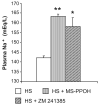Inhibition of the adenosine2A receptor-epoxyeicosatrienoic acid pathway renders Dahl salt-resistant rats hypertensive
- PMID: 19822802
- PMCID: PMC2789559
- DOI: 10.1161/HYPERTENSIONAHA.108.123570
Inhibition of the adenosine2A receptor-epoxyeicosatrienoic acid pathway renders Dahl salt-resistant rats hypertensive
Abstract
Adenosine-induced renovasodilation in Dahl rats is mediated via activation of adenosine(2A) receptors (A(2A)Rs) and stimulation of epoxyeicosatrienoic acid (EET) synthesis. Unlike Dahl salt-resistant rats, salt-sensitive rats exhibit an inability to upregulate the A(2A)R-EET pathway with salt loading; therefore, we examined the effect of in vivo inhibition of the A(2A)R-EET pathway on blood pressure and the natriuretic response to salt-loading in Dahl salt-resistant rats. N-Methylsulfonyl-6-(2-propargyloxyphenyl)hexanamide (MS-PPOH; 20 mg/kg per day), an epoxygenase inhibitor, or ZM241385 (ZM; 5 mg/kg per day), an A(2A)R antagonist, was given daily as an IV bolus dose for 3 days before and after placing rats on high salt intake (2% saline). After 3 days of high salt, systolic blood pressure per 24 hours increased from 108+/-2 mm Hg to 136+/-5 mm Hg and 140+/-4 mm Hg when treated with MS-PPOH or ZM, respectively (P<0.001). Plasma levels of EETs and dihydroxyeicosatrienoic acids during salt loading and MS-PPOH (29.3+/-1.8 ng/mL) or ZM treatment (9.8+/-0.5 ng/mL) did not increase to the same extent as in vehicle-treated rats (59.4+/-1.7 ng/mL; P<0.001), and renal levels of EETs+dihydroxyeicosatrienoic acids were 2-fold lower with MS-PPOH or ZM treatment. On day 3 of the high salt intake, MS-PPOH- and ZM-treated rats exhibited a positive Na(+) balance, and plasma Na(+) levels were significantly increased (163.3+/-1.2 and 158.1+/-4.5 mEq/L, respectively) compared with vehicle-treated rats (142.1+/-1 mEq/L), reflecting a diminished natriuretic capacity. These data support a role for the A(2A)R-EET pathway in the adaptive natriuretic response to modulate blood pressure during salt loading.
Conflict of interest statement
None.
Figures





Comment in
-
Adenosine2A receptors and epoxyeicosatrienoic acids: a recipe for salt and blood pressure regulation.Hypertension. 2009 Dec;54(6):1223-5. doi: 10.1161/HYPERTENSIONAHA.109.129981. Epub 2009 Oct 12. Hypertension. 2009. PMID: 19822801 Free PMC article. No abstract available.
Similar articles
-
Role of the adenosine(2A) receptor-epoxyeicosatrienoic acid pathway in the development of salt-sensitive hypertension.Prostaglandins Other Lipid Mediat. 2012 Aug;98(3-4):39-47. doi: 10.1016/j.prostaglandins.2011.12.002. Epub 2011 Dec 22. Prostaglandins Other Lipid Mediat. 2012. PMID: 22227265 Free PMC article. Review.
-
Failure to upregulate the adenosine2A receptor-epoxyeicosatrienoic acid pathway contributes to the development of hypertension in Dahl salt-sensitive rats.Am J Physiol Renal Physiol. 2008 Dec;295(6):F1696-704. doi: 10.1152/ajprenal.90502.2008. Epub 2008 Oct 1. Am J Physiol Renal Physiol. 2008. PMID: 18829737 Free PMC article.
-
Modulation of V1-receptor-mediated renal vasoconstriction by epoxyeicosatrienoic acids.Am J Physiol Regul Integr Comp Physiol. 2004 Jul;287(1):R181-7. doi: 10.1152/ajpregu.00555.2002. Epub 2004 Feb 26. Am J Physiol Regul Integr Comp Physiol. 2004. PMID: 14988086
-
Sexual dimorphism of renal alpha2-adrenergic receptor regulation in Dahl rats.Hypertens Res. 1996 Jun;19(2):83-9. doi: 10.1291/hypres.19.83. Hypertens Res. 1996. PMID: 10968200
-
Purinoceptors in renal microvessels: adenosine-activated and cytochrome P450 monooxygenase-derived arachidonate metabolites.Pharmacol Rep. 2005;57 Suppl:191-5. Pharmacol Rep. 2005. PMID: 16415499 Review.
Cited by
-
Adenosine2A receptors and epoxyeicosatrienoic acids: a recipe for salt and blood pressure regulation.Hypertension. 2009 Dec;54(6):1223-5. doi: 10.1161/HYPERTENSIONAHA.109.129981. Epub 2009 Oct 12. Hypertension. 2009. PMID: 19822801 Free PMC article. No abstract available.
-
Midkine Regulates BP through Cytochrome P450-Derived Eicosanoids.J Am Soc Nephrol. 2015 Aug;26(8):1806-15. doi: 10.1681/ASN.2013121259. Epub 2014 Nov 5. J Am Soc Nephrol. 2015. PMID: 25377079 Free PMC article.
-
Increases in plasma trans-EETs and blood pressure reduction in spontaneously hypertensive rats.Am J Physiol Heart Circ Physiol. 2011 Jun;300(6):H1990-6. doi: 10.1152/ajpheart.01267.2010. Epub 2011 Mar 11. Am J Physiol Heart Circ Physiol. 2011. PMID: 21398593 Free PMC article.
-
Pharmacological manipulation of arachidonic acid-epoxygenase results in divergent effects on renal damage.Front Pharmacol. 2014 Aug 15;5:187. doi: 10.3389/fphar.2014.00187. eCollection 2014. Front Pharmacol. 2014. PMID: 25177296 Free PMC article.
-
High salt diet exacerbates vascular contraction in the absence of adenosine A₂A receptor.J Cardiovasc Pharmacol. 2014 May;63(5):385-94. doi: 10.1097/FJC.0000000000000058. J Cardiovasc Pharmacol. 2014. PMID: 24390173 Free PMC article.
References
-
- Blaustein MP, Zhang J, Chen L, Hamilton BP. How does salt retention raise blood pressure? Am J Physiol Regul Integr Comp Physiol. 2006;290:R514–R523. - PubMed
-
- Guyton AC, Coleman TG, Cowley AV, Jr, Scheel KW, Manning RD, Jr, Norman RA., Jr Arterial pressure regulation. Overriding dominance of the kidneys in long-term regulation and in hypertension. Am J Med. 1972;52:584–594. - PubMed
-
- Aperia AC, Broberger CG, Soderlund S. Relationship between renal artery perfusion pressure and tubular sodium reabsorption. Am J Physiol. 1971;220:1205–1212. - PubMed
-
- McGiff JC, Ferreri NR. Eicosanoids and the Kidney. In: Robert Alpern, Steven Hebert., editors. The Kidney: Physiology and Pathophysiology. New York, NY: Elsevier Academic Press; 2008. pp. 359–384.
-
- Imig JD, Navar LG, Roman RJ, Reddy KK, Falck JR. Actions of epoxygenase metabolites on the preglomerular vasculature. J Am Soc Nephrol. 1996;7:2364–2370. - PubMed
Publication types
MeSH terms
Substances
Grants and funding
LinkOut - more resources
Full Text Sources

